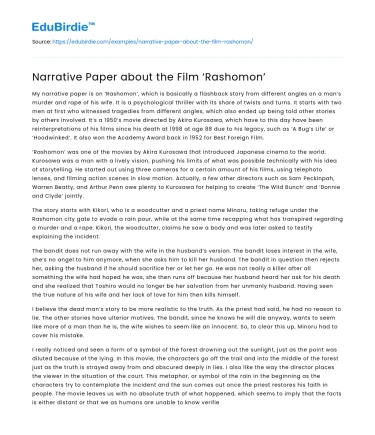My narrative paper is on ‘Rashomon’, which is basically a flashback story from different angles on a man’s murder and rape of his wife. It is a psychological thriller with its share of twists and turns. It starts with two men at first who witnessed tragedies from different angles, which also ended up being told other stories by others involved. It’s a 1950’s movie directed by Akira Kurosawa, which have to this day have been reinterpretations of his films since his death at 1998 at age 88 due to his legacy, such as ‘A Bug’s Life’ or ‘Hoodwinked’. It also won the Academy Award back in 1952 for Best Foreign Film.
‘Rashomon’ was one of the movies by Akira Kurosawa that introduced Japanese cinema to the world. Kurosawa was a man with a lively vision, pushing his limits of what was possible technically with his idea of storytelling. He started out using three cameras for a certain amount of his films, using telephoto lenses, and filming action scenes in slow motion. Actually, a few other directors such as Sam Peckinpah, Warren Beatty, and Arthur Penn owe plenty to Kurosawa for helping to create ‘The Wild Bunch’ and ‘Bonnie and Clyde’ jointly.
Save your time!
We can take care of your essay
- Proper editing and formatting
- Free revision, title page, and bibliography
- Flexible prices and money-back guarantee
The story starts with Kikori, who is a woodcutter and a priest name Minoru, taking refuge under the Rashomon city gate to evade a rain pour, while at the same time recapping what has transpired regarding a murder and a rape. Kikori, the woodcutter, claims he saw a body and was later asked to testify explaining the incident.
The bandit does not run away with the wife in the husband’s version. The bandit loses interest in the wife, she’s no angel to him anymore, when she asks him to kill her husband. The bandit in question then rejects her, asking the husband if he should sacrifice her or let her go. He was not really a killer after all something the wife had hoped he was, she then runs off because her husband heard her ask for his death and she realized that Toshiro would no longer be her salvation from her unmanly husband. Having seen the true nature of his wife and her lack of love for him then kills himself.
I believe the dead man’s story to be more realistic to the truth. As the priest had said, he had no reason to lie. The other stories have ulterior motives. The bandit, since he knows he will die anyway, wants to seem like more of a man than he is, the wife wishes to seem like an innocent. So, to clear this up, Minoru had to cover his mistake.
I really noticed and seen a form of a symbol of the forest drowning out the sunlight, just as the point was diluted because of the lying. In this movie, the characters go off the trail and into the middle of the forest just as the truth is strayed away from and obscured deeply in lies. I also like the way the director places the viewer in the situation of the court. This metaphor, or symbol of the rain in the beginning as the characters try to contemplate the incident and the sun comes out once the priest restores his faith in people. The movie leaves us with no absolute truth of what happened, which seems to imply that the facts is either distant or that we as humans are unable to know verified truth; one example is when the passerby stated that people lie to others and ourselves.
When the child is discovered cloaked in a kimono with some amulet, and the commoner goes to steal it, the wood cutter is enraged. He doesn’t have much of a chance to examine the child, but still knows that it was wrapped in that fashion. After he is shamed and the commoner leaves with the stolen goods, the wood cutter says he will take the child home because, since he has six already, it won’t be that much of a burden. The last man who has heard all the stories says that act has restored his faith in human kind and the movie ends. But how did the child get the amulet and the kimono, in the first place both are items that the wood cutter likely stole from the scene of the rape murder. He then wrapped up his own seventh child in the items and set the bundled child out for someone else to adopt. When he is shamed and takes the child at the end, he is returning home with his own child and getting praised in the process.






 Stuck on your essay?
Stuck on your essay?

